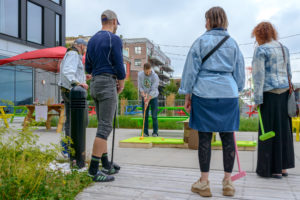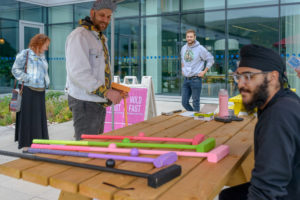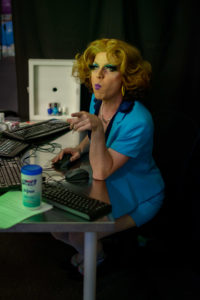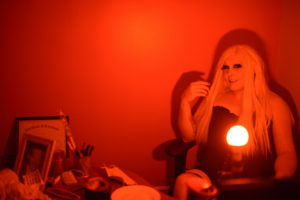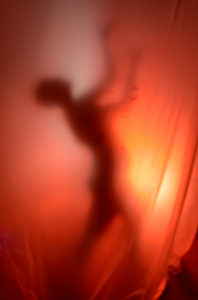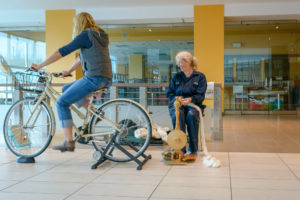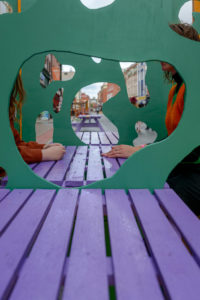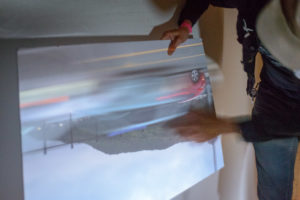HOLD FAST 2021 Report by Carmella Gray-Cosgrove
In Audre Lorde’s 1978 essay, The Uses of the Erotic, she says that in sharing joy, we, the sharers, bridge the gaps that exist between us and lessen the threat of our differences. I am paraphrasing, but couldn’t get this out of my head as I attended the workshops, installations and artist talks that made up this year’s Hold Fast Contemporary Arts Festival. Lorde’s essay is uniquely suited to this moment as we learn to be together again, to share in joy in new ways and in a context where our collectivity, our communal health, is acutely apparent.
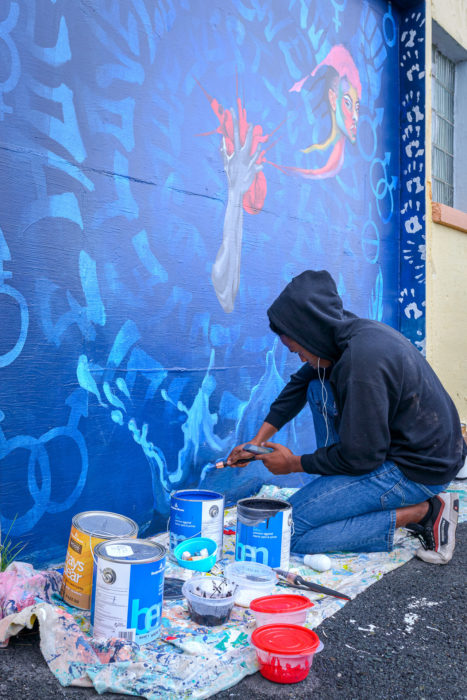 This year, Hold Fast took place alongsideLawnya Vawnya, a festival of music and art, and events from the two festivals criss-crossed through St. John’s over the course of the week, with Eastern Edge gallery, the spaces surrounding it in the Baird Building, and the harbour front as the epicentre of the action. Outside Eastern Edge, Brian Amadi worked throughout Hold Fast on a new mural that was initiated through a collaboration between the BIPOC Creators Collective and Eastern Edge. In the centre of the mural a hand clutches a human heart. The week was inherently a celebration, a party in the summer’s brief reprieve from the pandemic on this island that has worked so hard to stay safe. The events were joyful, as people from this city and visiting from around the country flocked to venues and gathered in what felt like a pilgrimage to be together again, to take part in art again, and to participate in “the sharing of joy, whether physical, emotional, psychic, or intellectual” that Lorde points to.
This year, Hold Fast took place alongsideLawnya Vawnya, a festival of music and art, and events from the two festivals criss-crossed through St. John’s over the course of the week, with Eastern Edge gallery, the spaces surrounding it in the Baird Building, and the harbour front as the epicentre of the action. Outside Eastern Edge, Brian Amadi worked throughout Hold Fast on a new mural that was initiated through a collaboration between the BIPOC Creators Collective and Eastern Edge. In the centre of the mural a hand clutches a human heart. The week was inherently a celebration, a party in the summer’s brief reprieve from the pandemic on this island that has worked so hard to stay safe. The events were joyful, as people from this city and visiting from around the country flocked to venues and gathered in what felt like a pilgrimage to be together again, to take part in art again, and to participate in “the sharing of joy, whether physical, emotional, psychic, or intellectual” that Lorde points to.
In Lily Taylor’s “Build Your Own mini-mini Golf” workshop, participants built their own table top mini-putt, in what Taylor framed as a project inspired by a Simpson’s episode in which Lisa teaches Bart the value of mindfulness. I certainly felt the flow state as I immersed myself in my own mini-mini golf course: glue-gunning green fleece to cardboard, bending pipe cleaner around the perimeter, and finally tapping a ball bearing with my tiny putter down a ramp, through an archway and into the hole next to a tiny pink flag. On the Art Crawl, Taylor installed “Putt-Putt Hurray!”—an artist’s rendering of a regular sized mini-putt course overlooking the ocean behind the Alt Hotel and aimed at all ages, during which children launched golf balls around the patio or picked them up and placed them with clammy hands for a hole-in-one. The course was replete with a Smoky the Bear putting tunnel and an inflatable pond. Taylor’s work was about participation and fun, about gathering and connection.

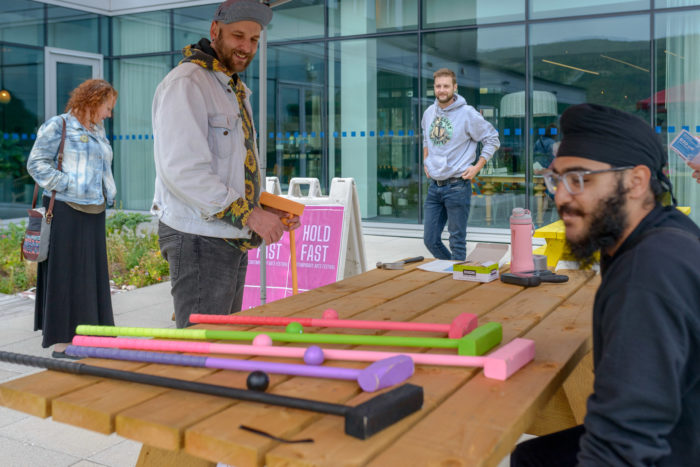
 Also during the Art Crawl, the Phlegm Fatales pulled off their epic performance of The Labourinth: a corporate haunted house of “the morbidly mundane,” headquarters of “Phlegmcorp,” located in an office building and performing the absurdism of bureaucracy, capitalism and life within these systems. The Labourinth skillfully satirized the bureaucratization of gender and gender non-conformity, the constant scrutiny by systems with the power to define and document gender and naming. The Phlegm Fatales are an all non-binary drag collective and their installation was an otherworldly montage of the daily grind. Irma Gerd greeted attendees who, as they entered the building, became new employees of the corporation. At her cluttered desk she took down employee information and clacked frenetically on her keyboard, dubbing each person Gary. Further along Madame Daddy, “HR and relationship consultant” waxed poetic about the office family. In the fabrication department, \garbagefile danced in red light behind sheet plastic. They were Phlegmcorp’s “special product,” as they flexed into controlled backbends and pressed their face against the plastic. The attendant drawled “Let me know if you want to exist.” To paraphrase from the collective’s artist talk, the Phlegm Fatales engage in acts of world building, and in my view the world they made at The Labourinth was about joy and resistance, subversion, transformation and maybe most importantly it was about satire and having extreme amounts of fun.
Also during the Art Crawl, the Phlegm Fatales pulled off their epic performance of The Labourinth: a corporate haunted house of “the morbidly mundane,” headquarters of “Phlegmcorp,” located in an office building and performing the absurdism of bureaucracy, capitalism and life within these systems. The Labourinth skillfully satirized the bureaucratization of gender and gender non-conformity, the constant scrutiny by systems with the power to define and document gender and naming. The Phlegm Fatales are an all non-binary drag collective and their installation was an otherworldly montage of the daily grind. Irma Gerd greeted attendees who, as they entered the building, became new employees of the corporation. At her cluttered desk she took down employee information and clacked frenetically on her keyboard, dubbing each person Gary. Further along Madame Daddy, “HR and relationship consultant” waxed poetic about the office family. In the fabrication department, \garbagefile danced in red light behind sheet plastic. They were Phlegmcorp’s “special product,” as they flexed into controlled backbends and pressed their face against the plastic. The attendant drawled “Let me know if you want to exist.” To paraphrase from the collective’s artist talk, the Phlegm Fatales engage in acts of world building, and in my view the world they made at The Labourinth was about joy and resistance, subversion, transformation and maybe most importantly it was about satire and having extreme amounts of fun.
 In a more introspective experience of gendered art and pleasure, I spun fleece into yarn using a hand spindle in Robyn Love’s Spindle Yarn workshop. I was surrounded by people I didn’t know, distanced and masked but together making the same thing with our hands in this tradition of spinning passed down over millennia. At Love’s installation, Spin Cycle, in Atlantic Place, participants pedaled the bike that Love had attached to her spinning wheel with yarn. The rider turned the crank that propelled the drive-train that spun the wheel into which Love fed fleece as the pedalling sped up and slowed down. The physical labour of the cyclist powering Love’s creation in a fleeting collaboration.
In a more introspective experience of gendered art and pleasure, I spun fleece into yarn using a hand spindle in Robyn Love’s Spindle Yarn workshop. I was surrounded by people I didn’t know, distanced and masked but together making the same thing with our hands in this tradition of spinning passed down over millennia. At Love’s installation, Spin Cycle, in Atlantic Place, participants pedaled the bike that Love had attached to her spinning wheel with yarn. The rider turned the crank that propelled the drive-train that spun the wheel into which Love fed fleece as the pedalling sped up and slowed down. The physical labour of the cyclist powering Love’s creation in a fleeting collaboration.
On the Pedestrian Mall, Drew Pardy and Elizabeth Cook created a friendship pavilion, a bright yellow and orange rectangular pergola with purple picnic tables and green dividers cut with oblong openings separating the tables. A gathering place, a place to foster friendship and community, a reclamation of public space made through collaboration. Pardy and Cook described their process as employing a methodology of friendship—an intimate approach to collaborative art making that values conversation and compassion, vulnerability, and collective learning as foundational elements in their process.

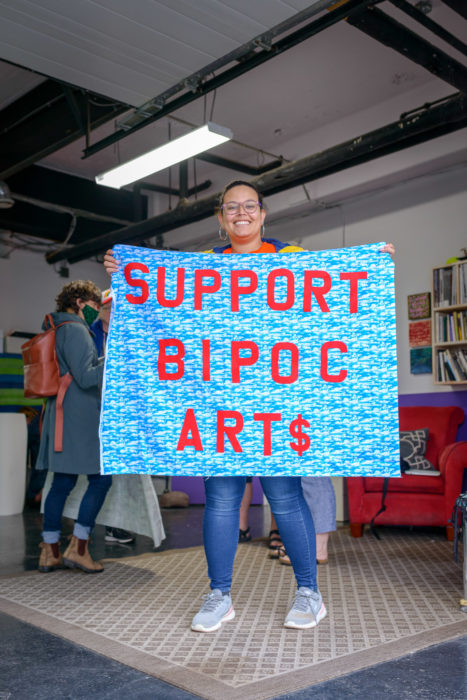 On the last day of Hold Fast, in front of Eastern Edge in the fog and drizzle, as friends and community walked by holding Aram Han Sifuentes’ colourful appliqué banners for a Protest Banner Walk, and others gathered in the adjacent garage for a punk show, looking out into the narrows, I stepped into Dark NL’s human sized camera obscura with my three-year-old holding my hand. We had just left the exhibition in the main gallery at Eastern Edge called Holding Place: Emily Neufeld’s chunk of sea ice melting onto the gallery floor against a projection of a house in New Chelsea she cut into with a saw, holes filled with pre-Cambrian rocks that hold the layers of history of this island; prints of Andrew Testa’s intaglio plates scratched after long walks dragged behind him; Christeen Francis’ overlaid video footage of St. John’s. Translations of this land, ways of making sense of place, disassembling and reassembling.
On the last day of Hold Fast, in front of Eastern Edge in the fog and drizzle, as friends and community walked by holding Aram Han Sifuentes’ colourful appliqué banners for a Protest Banner Walk, and others gathered in the adjacent garage for a punk show, looking out into the narrows, I stepped into Dark NL’s human sized camera obscura with my three-year-old holding my hand. We had just left the exhibition in the main gallery at Eastern Edge called Holding Place: Emily Neufeld’s chunk of sea ice melting onto the gallery floor against a projection of a house in New Chelsea she cut into with a saw, holes filled with pre-Cambrian rocks that hold the layers of history of this island; prints of Andrew Testa’s intaglio plates scratched after long walks dragged behind him; Christeen Francis’ overlaid video footage of St. John’s. Translations of this land, ways of making sense of place, disassembling and reassembling.
Inside the camera obscura Johnny Lush explained the lens, the process, and we marvelled at the image of the harbour refracting back at us on the opposite wall of the camera. Somehow that image was more beautiful to me than the thing itself and it seemed like a metaphor for the whole festival: an inversion, a subversion, a new perspective, joy, community, being together. My kid peered out the hole and blocked the light, trying to make sense of what we were doing and seeing. And in that little dark space we were suspended for a minute and close. When my kid moved away again, the image reappeared. The cars parked along the road, the harbour fence, the boats along the dock, the ocean, and out of focus, the south side hills, their invisible berries and foot paths, and behind it all the grey sky, everything upside down and backwards.
 Carmella Gray-Cosgrove is from Vancouver, the traditional territory of the Musqueam, Squamish, and Tsleil-Waututh peoples, and has lived in St. John’s on Ktaqmkuk for over a decade. Her debut short story collection is forthcoming from Arsenal Pulp Press in September 2021. Her writing has appeared in Prism, Broken Pencil, The New Quarterly and elsewhere. She is the non-fiction, reviews and features editor for Riddle Fence.
Carmella Gray-Cosgrove is from Vancouver, the traditional territory of the Musqueam, Squamish, and Tsleil-Waututh peoples, and has lived in St. John’s on Ktaqmkuk for over a decade. Her debut short story collection is forthcoming from Arsenal Pulp Press in September 2021. Her writing has appeared in Prism, Broken Pencil, The New Quarterly and elsewhere. She is the non-fiction, reviews and features editor for Riddle Fence.


